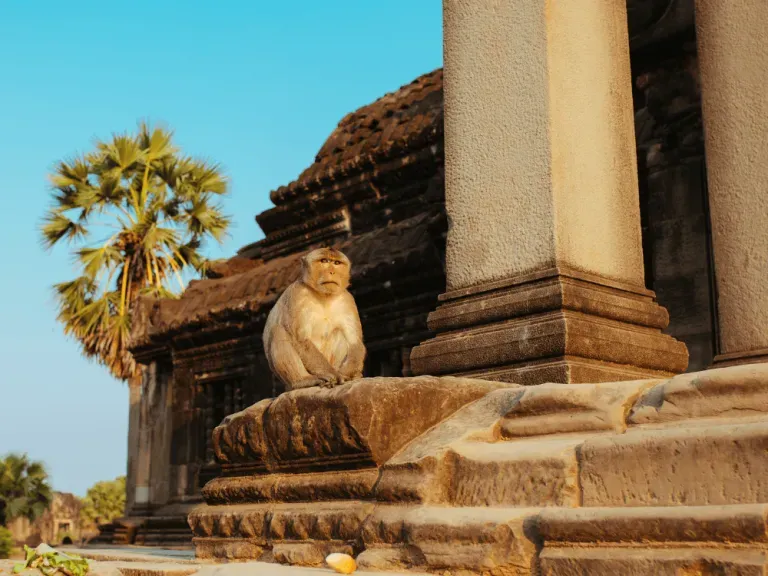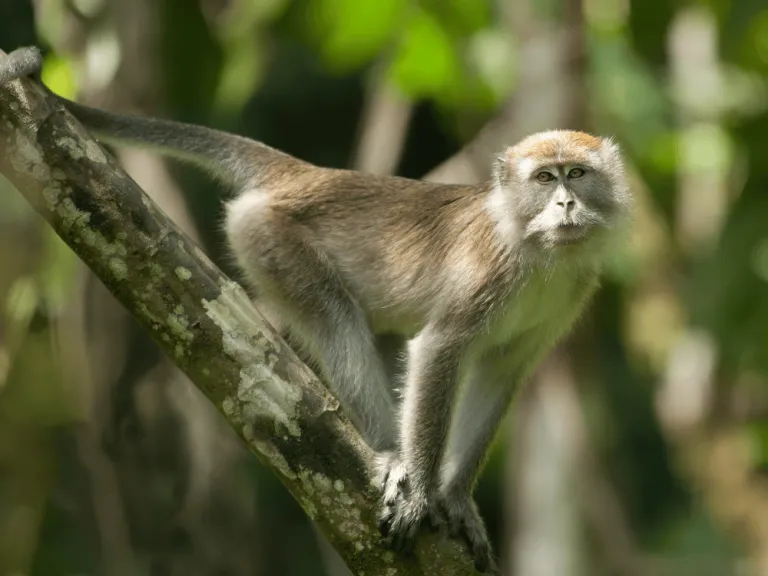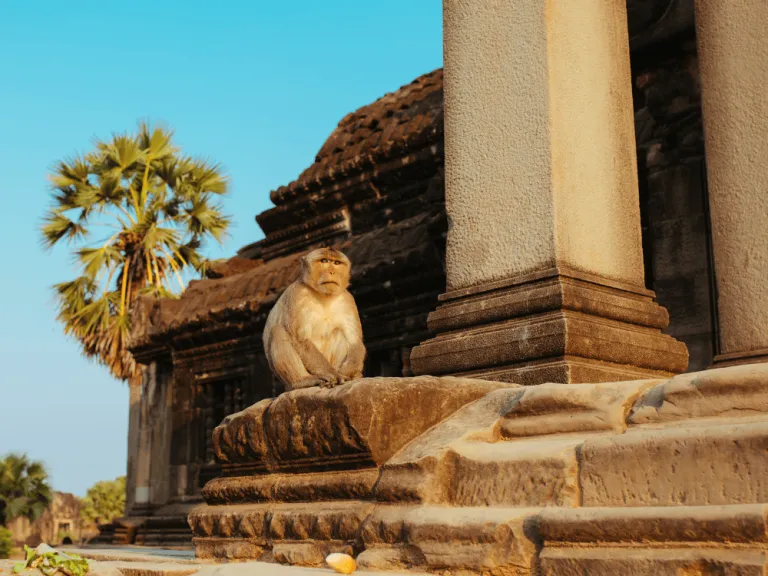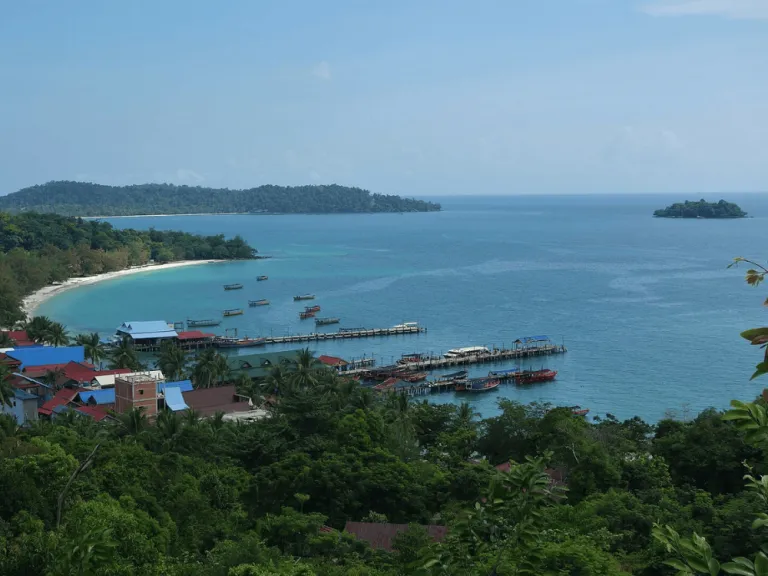Our favourite places to stay on this sleepy Cebu island.
Monkey Attacks in Cambodia? How YouTubers Endanger Tourist Safety

You're not alone if you’ve ever dreamed of visiting Cambodia’s legendary Angkor Wat. This ancient temple complex, a UNESCO World Heritage Site, attracts millions of visitors every year, including many Filipinos who love history, culture, and adventure. But while the majestic stone ruins are awe-inspiring, another group of ‘locals’ is making headlines for all the wrong reasons—the resident monkeys.
 Angkor Wat | Dmitry Rukhlenko via Canva Pro
Angkor Wat | Dmitry Rukhlenko via Canva Pro
Recently, Cambodian officials have issued a warning about aggressive macaques roaming the temple grounds, and guess what? YouTubers and social media content creators are to blame. Their constant feeding and provoking of these wild animals have led to a rise in monkey-related incidents—including attacks on tourists, vandalized stonework, and destroyed information boards.
Also read: My DIY Trip to Vietnam, Cambodia & Thailand for Less than ₱20k
Angkor Wat’s macaque problem: What’s really happening?
 Macaque | Stephane Bidouze via Canva Pro
Macaque | Stephane Bidouze via Canva Pro
The lush forests surrounding Angkor Wat have always been home to macaques. These monkeys are a common sight in many Southeast Asian temples, including some in the Philippines, like those in Loboc, Bohol, or Corregidor Island. But here’s the issue—they’re supposed to be wild animals, not tourist attractions. Unfortunately, some YouTubers have been exploiting them for content, feeding them unhealthy human food, and even teasing or mistreating them to provoke reactions to their videos.
The result? The macaques have lost their natural fear of humans and have become increasingly aggressive, territorial, and mischievous. Reports say they have been biting tourists, stealing food and belongings, and even climbing on ancient stone structures—damaging them in the process. Officials are concerned about both the safety of visitors and the preservation of Cambodia’s most treasured landmark.
A growing concern for tourists and conservationists
 Macaque Monkey at Angkor Wat | Aleksejs Bergmanis via Getty Images
Macaque Monkey at Angkor Wat | Aleksejs Bergmanis via Getty Images
The Apsara National Authority (ANA), the agency responsible for managing Angkor Wat, has urged visitors to keep their distance from the monkeys. They’ve also warned against feeding them, as this reinforces their aggressive behaviour and increases the risk of bites and injuries.
Aside from the dangers to humans, the monkeys are also harming the centuries-old stone carvings and temple structures by climbing on them and pushing stones down. This kind of damage is irreversible—and that’s a big deal when we’re talking about one of the most important historical sites in the world.
In response, Cambodian authorities are exploring solutions, including a plan to conduct a monkey census and relocate those that pose a danger to tourists and the temples.
Responsible tourism at Angkor Wat: Protecting wildlife and heritage
As Filipino travellers, we love to explore and document our adventures, whether it’s through TikTok, vlogs, or Instagram. And there’s nothing wrong with sharing our experiences! But when it comes to wildlife encounters, we have to remember a golden rule: Observe, don’t interfere.
Here’s how you can be a responsible tourist when visiting Angkor Wat—or any place where wildlife is present:
Do not feed the animals: Feeding monkeys changes their natural behaviour, making them reliant on humans and more likely to become aggressive.
Keep your distance: No matter how cute they look, wild animals can be unpredictable. Admire them from afar and respect their space.
Secure your belongings: Macaques are known for stealing food, sunglasses, and even smartphones! Keep your bags zipped and avoid carrying loose items.
Never provoke or tease them: Some YouTubers have been caught abusing monkeys just for views. This is cruel and unethical. Always treat animals with kindness and respect.
Follow local guidelines: The ANA and local guides know best—if they tell you to stay away from the monkeys, listen to them.
Why Angkor Wat is still worth visiting
 Koh Rong | Rômulo Gama Ferreira via Wikimedia Commons
Koh Rong | Rômulo Gama Ferreira via Wikimedia Commons
Angkor Wat remains a must-visit destination for Filipinos who love history, culture, and adventure despite the monkey troubles. This ancient city, built between the 9th and 15th centuries, was once the heart of the powerful Khmer Empire. Its stunning stone carvings, towering spires, and mystical atmosphere make it one of the most breathtaking landmarks in the world.
Beyond Angkor Wat, Cambodia offers so much more for Filipino travellers! You can explore the floating villages of Tonlé Sap, the vibrant markets of Siem Reap, or the breathtaking beaches of Koh Rong.
Also read: 8 Wellness Retreats in Asia for a Full Mind-Body Reset
The bottom line: Travel smart, be kind
Angkor Wat’s monkeys are a reminder that while travelling is about experiencing new places, it also comes with responsibilities. Whether you’re exploring Cambodia, the Philippines, or anywhere else, always remember to respect nature, protect heritage sites, and be kind to animals.
After all, the best way to experience the world is not just to capture it on camera but to appreciate and preserve it for future generations.
Published at
About Author
Jennylene Dela Cruz
Subscribe our Newsletter
Get our weekly tips and travel news!
Recommended Articles
10 Bantayan Island Resorts, Hotels, and Rentals for Your Tropical Escape 10 Best Mountain Cafes in the Philippines for Your Peak Coffee Experience Coffee date on the mountains, anyone?
10 Family Outing Ideas in Metro Manila Under ₱500 Looking for a weekend bonding with the family under ₱500? Head to these places, pronto!
10 Long Weekends in the Philippines in 2023 Book those flights ASAP.
Top 10 Post-Breakup Destinations for Healing and Self-Rediscovery Ready for a solo travel?
Latest Articles
Mango Ranch Waterpark: Negros Oriental’s Hottest New Attraction Make a splash at Negros Oriental’s newest adventure hotspot!
Nagsasa Cove Zambales Travel Guide: Hidden Beach Escape A serene cove for campers and chill seekers
A Must-Visit Food Destination in Japan: Restaurant of Mistaken Orders A must-visit where mistakes make meals memorable!
Best Travel Gifts for Travellers: Practical and Thoughtful Ideas for 2025 Top Travel Gift Ideas for 2025
Your Ultimate Guide to Must-Visit Summer Destinations in the Philippines Perfect for adventure seekers and beach lovers!

